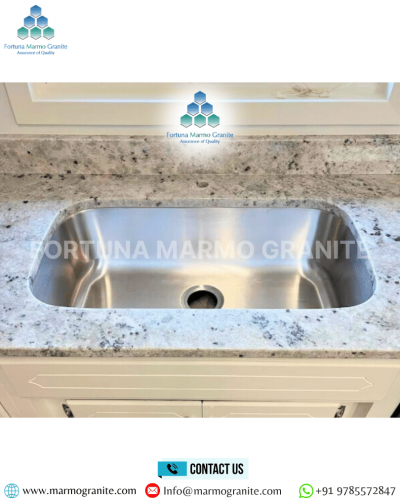"Everything You Need to Know About Faux Granite Countertops"
When remodeling or renovating a kitchen or bathroom, the choice of countertops plays a pivotal role in setting the tone of the entire space. Granite countertops have long been a symbol of luxury and durability. However, real granite can be expensive and requires a level of maintenance that may not be appealing to every homeowner. Faux granite countertops offer an affordable and practical way to enjoy the beauty of real granite without the high cost or demanding maintenance. In this blog, we'll explain what faux granite is, how manufacturers create it, and why it's becoming a popular choice. You'll also learn about its key benefits and see how it compares to real granite in terms of cost, maintenance, durability, and overall performance.
What Are Faux Granite Countertops?
Faux granite countertops are engineered surfaces designed to look like natural granite but are typically made from a blend of materials like laminate, quartz, or solid surface materials. While they emulate the aesthetic appeal of granite, they are crafted using synthetic processes, making them more affordable and easier to maintain than natural stone. Faux granite can closely replicate the intricate patterns, colors, and textures of real granite, offering a similar visual effect without the hefty price tag.
How Are Faux Granite Countertops Made?
1.Laminate Faux Granite
Laminate countertops are among the most affordable faux granite options available. Manufacturers create them by bonding layers of plastic laminate to a particleboard or MDF (Medium-Density Fiberboard) base. The top layer features a printed design that replicates the look of natural granite, enhanced by high-definition printing technology. Some varieties even include textured surfaces to give a more realistic stone-like feel.
These countertops come in a wide range of colors and patterns, from soft marble-style tones to bold granite-inspired finishes. Although laminate isn't as durable as other faux granite materials, it provides excellent value for the cost, making it a smart choice for homeowners on a budget.
2.Quartz Faux Granite
Quartz countertops are a popular alternative to granite, offering a look and feel that closely resembles natural stone. Manufacturers create these surfaces by blending natural quartz minerals with resins and pigments, then compressing the mixture into solid slabs. The result is a countertop that's strong, durable, and highly resistant to stains and scratches.
Because quartz is non-porous, it doesn't need sealing like natural granite, which makes maintenance simple. Compared to laminate, quartz provides greater durability and a more realistic appearance, with veining and patterns that beautifully mimic real granite. Although it costs more than laminate, quartz remains a more affordable option than natural granite.
3.Solid Surface Faux Granite
Solid surface countertops, such as Corian, combine acrylic, resin, and mineral materials to create a smooth and durable surface. Manufacturers can mold them into various shapes, making these countertops a versatile choice for kitchens and bathrooms. By adding pigments and patterns, they can easily replicate the look of natural granite.
A major advantage of solid surface faux granite countertops is their seamless finish, as installers can join the material without visible lines. These countertops also resist stains, scratches, and bacteria, offering a practical and hygienic solution for any space.
Benefits of Faux Granite Countertops
1.Cost-Effective
2.Low Maintenance
Real granite requires regular sealing to prevent stains and moisture damage, whereas faux options like quartz and laminate are completely non-porous, eliminating the need for sealing. These materials clean easily with a damp cloth, no special cleaners needed..
3.Durability
Real granite is durable, but faux options like quartz and solid surface countertops are also highly resilient. Quartz resists stains, scratches, and heat, making it ideal for high-traffic areas. Laminate, while less durable, still offers good resistance to everyday wear.
4.Wide Range of Designs
Faux granite countertops come in a wide variety of colors, patterns, and finishes, allowing homeowners to choose a style that complements their décor. Whether you prefer a subtle, classic look or something bold and modern, faux granite offers an array of design options.
How Faux Granite Compares to Real Granite
Appearance
Real granite is a natural stone, and no two slabs are exactly alike. Its veining and patterns are unique, which gives it an organic and luxurious look. Faux granite, while it can closely mimic real granite, may lack the intricate patterns and depth found in natural stone. However, with advancements in technology, materials like quartz can replicate the look of natural granite almost seamlessly.
Durability
Real granite is incredibly durable and heat-resistant. It can withstand heavy use and is less prone to scratches and stains compared to some faux granite options. Quartz and solid surface countertops are also durable but may be more prone to scratches from sharp objects or high heat compared to real granite.
Maintenance
Real granite requires sealing every one to two years to protect against moisture and stains. Faux granite options like quartz and laminate are non-porous and require little maintenance, making them more convenient for homeowners who don't want to worry about ongoing care.
Cost
Faux granite is significantly more affordable than real granite. While natural granite can cost anywhere from $40 to $100 per square foot (or more), faux granite options typically cost less, making them an attractive choice for homeowners on a budget.


